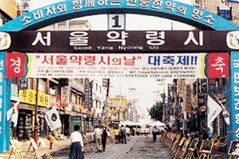Oriental Medicine Street
Welcome to Dongdaemun-gu

Seoul Yangnyeongsi Her Medicine Festival
‘Bojewon’ used to be located in the west of Seonnongdan, outside Heung-inmun (the present-day Anam-dong Rotary). The road, leading out from Heung-inmun, forks in two ways once from Dongmyo. Bojewon could be found if a traveler followed the road in the northeastern direction. A traveler would have reached Nowon Station from Bojewon, passing by Anam-dong-cheon, Jegi-hyeon, Goam, and Suyu-ri. This road was a major channel through which drapery was transported between the capital city and other provinces, such as Gangwon-do and Hamgyeong-do. The expansion of the road system also caused the expansion in the network of ‘yeok’ (stations) and ‘won’ (inns for government officials). A yeok was, by principal, to be installed along the road at every 30-ri linking Seoul to other regions of Korea.
